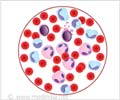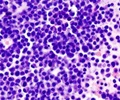Acute lymphoblastic leukemia is the most common type of cancer in children and its likely cause is revealed in a unified theory by a leading UK scientist.

- Landmark paper sets out 'unified theory' for cause of childhood leukemia - and finds it is likely to be preventable
- Disease develops in two steps: a mutation before birth, then further genetic change after birth triggered by infection
- Evidence challenges 100 years of controversy around other possible environmental 'causes' of the disease
His research concludes that the disease is caused through a two-step process of genetic mutation and exposure to infection that means it may be preventable with treatments to stimulate or 'prime' the immune system in infancy.
The first step involves a genetic mutation that occurs before birth in the fetus and predisposes children to leukemia - but only 1 per cent of children born with this genetic change go on to develop the disease.
The second step is also crucial. The disease is triggered later, in childhood, by exposure to one or more common infections, but primarily in children who experienced 'clean' childhoods in the first year of life, without much interaction with other infants or older children.
Acute lymphoblastic leukemia is particularly prevalent in advanced, affluent societies and is increasing in incidence at around 1 per cent per year.
Professor Greaves suggests childhood ALL is a paradox of progress in modern societies - with lack of microbial exposure early in life resulting in immune system malfunction.
Advertisement
Professor Greaves challenged previous reports of possible environmental causes, such as ionizing radiation, electricity cables, electromagnetic waves or man-made chemicals - arguing that none are supported by robust evidence as major causes.
Advertisement
Professor Greaves suggests that childhood leukemia, in common with type I diabetes, other autoimmune diseases and allergies, might be preventable if a child's immune system is properly 'primed' in the first year of life - potentially sparing children the trauma and life-long consequences of chemotherapy.
His studies of identical twins with ALL showed that two 'hits' or mutations were required. The first arises in one twin in the womb but produces a population of pre-malignant cells that spread to the other twin via their shared blood supply. The second mutation arises after birth and is different in the two twins.
Population studies in people together with animal experiments suggest this second genetic 'hit' can be triggered by infection - probably by a range of common viruses and bacteria. In one unique cluster of cases investigated by Professor Greaves and colleagues in Milan, all cases were infected with flu virus.
Researchers also engineered mice with an active leukemia-initiating gene, and found that when they moved them from an ultra-clean, germ-free environment to one that had common microbes, the mice developed ALL.
Population studies have found that early exposure to infection in infancy such as day care attendance and breast feeding can protect against ALL, most probably by priming the immune system. This suggests that childhood ALL may be preventable.
Professor Greaves is now investigating whether earlier exposure to harmless 'bugs' could prevent leukemia in mice - with the possibility that it could be prevented in children through measures to expose them to common but benign microbes.
Professor Greaves emphasizes two caveats. Firstly, while patterns of exposure to common infections appear to be critical, the risk of childhood leukemia, like that of most common cancers, is also influenced by inherited genetic susceptibility and chance. Secondly, infection as a cause applies to ALL specifically - other rarer types including infant leukemia and acute myeloid leukemia probably have different causal mechanisms.
Professor Mel Greaves, Director of the Centre for Evolution and Cancer at The Institute of Cancer Research, London, said: "I have spent more than 40 years researching childhood leukemia, and over that time there has been huge progress in our understanding of its biology and its treatment - so that today around 90 per cent of cases are cured. But it has always struck me that something big was missing, a gap in our knowledge - why or how otherwise healthy children develop leukemia and whether this cancer is preventable.
"This body of research is a culmination of decades of work, and at last provides a credible explanation for how the major type of childhood leukemia develops. The research strongly suggests that ALL has a clear biological cause and is triggered by a variety of infections in predisposed children whose immune systems have not been properly primed. It also busts some persistent myths about the causes of leukemia, such as the damaging but unsubstantiated claims that the disease is commonly caused by exposure to electro-magnetic waves or pollution.
"I hope this research will have a real impact on the lives of children. The most important implication is that most cases of childhood leukemia are likely to be preventable. It might be done in the same way that is currently under consideration for autoimmune disease or allergies - perhaps with simple and safe interventions to expose infants to a variety of common and harmless 'bugs'." Professor Paul Workman, Chief Executive of The Institute of Cancer Research, London, said: "This research has been something of a personal, 30-year quest for Professor Mel Greaves - who is one of the UK's most influential and iconic cancer researchers. His work has cut through the myths about childhood leukemia and for the first time set out a single unified theory for how most cases are caused.
"It's exciting to think that, in future, childhood leukemia could become a preventable disease as a result of this work. Preventing childhood leukemia would have a huge impact on the lives of children and their families in the UK and across the globe."
Source-Eurekalert














